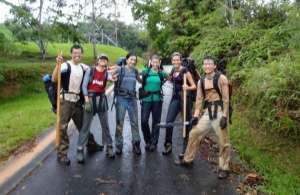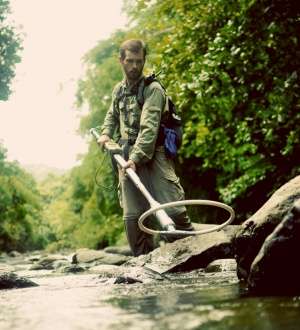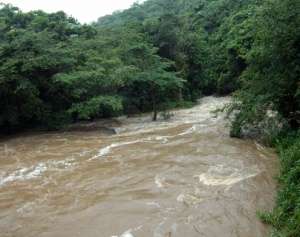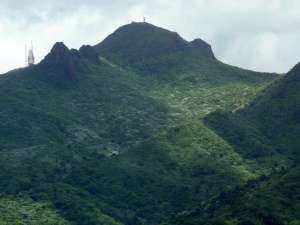Scientists characterize 'hot spots and hot moments' in America's tropics

The Luquillo Mountains of Puerto Rico are prone to extremes. Nearly all the rain for the year pours down in two drenching months. Lush, rolling forests give way to rocky, barren peaks. Even the soil is extreme, storing carbon differently than many other soil types, in highly localized iron minerals.
Such unusual characteristics have drawn the attention of a team of researchers from the Department of Earth and Environmental Science at the University of Pennsylvania, who have spent the last five years studying the region's waterways, air and terrain.
Recently, the Penn team and colleagues from the University of New Hampshire, University of California-Berkeley and other institutions got word that their project, part of the National Science Foundation's Critical Zone Observatory program, has been renewed for another five years. And though one of the project's primary architects, the late Fred Scatena, former chair and professor in the EES department, at Penn isn't around to participate in the ongoing work, "his fingerprints are all over it," says Alain Plante, associate professor in the department and one of the primary investigators of the research.
The NSF describes the critical zone as the area "from the tops of the trees to the bottom of the groundwater…. a living, breathing, constantly evolving boundary layer where rock, soil, water, air and living organisms interact." The agency has funded ten projects in locations across the United States to explore how the critical zone forms, how it functions, how it has changed over time and how it will change into the future, both affecting and being affected by humans.
The Luquillo Critical Zone Observatory, or LCZO for short, was Scatena's "baby," and the only observatory dedicated to studying a tropical environment. Scatena, who had research experience in Puerto Rico dating back to the late 1980s, served as the principal investigator for the first five years of the $5 million grant. Using what is known as a "systems approach," he led the team in tackling basic questions about the Luquillo Mountains by taking a holistic view, including experts in water, soil, vegetation and atmosphere.
As the grant wound down, the researchers geared up to apply for a renewal. Considering their work up to that point, a theme emerged.
Though most think of geological and atmospheric changes as happening on grand scales of time and space, Scatena and his colleagues observed that highly localized areas, like the soil's iron minerals, and brief time periods, like individual rain storms, took on an outsized importance in shaping the specialized environment of Luquillo.
"We came to realize that a lot of the action in Puerto Rico is localized in space and happens in a very short period of time," says Plante. "Fred came up with this idea of hot spots and hot moments. That became the theme of the renewal."
The researchers received word that NSF had granted the renewal of their project in December 2013—another $5 million to support the research over five years. Scatena did not live to see it, however. He passed away from cancer at the age of 58 in January 2013.

The overall project is now led by William McDowell of the University of New Hampshire and Plante heads Penn's portfolio of research, working with department colleagues Douglas Jerolmack, an associate professor, Jane Willenbring, an assistant professor and Art Johnson, department chair. Each of the scientists has multiple lines of research in Puerto Rico.
Plante, together with Johnson, focuses on the soil biogeochemistry and carbon and nutrient cycling.
"Art, Fred and I were involved in what we called the 'big dig,'" Plante says.
Their effort involved digging more than two hundred soil pits to examine the cycling of carbon, nitrogen and other elements. The dig turned up the unusual carbon storage characteristics in the soil of the Luquillo, which could have implications for greenhouse gas emissions because of the way carbon may be released from the ground during rainfalls.
Jerolmack, meanwhile, has studied how large pieces of sediment, like boulders, move down rivers and interact with one another as they go, shaping the landscape of water bodies and flood plains. Willenbring has looked at how the process of erosion has shaped the landscape over both long and short time scales. And a project initiated by Scatena is ongoing, monitoring how moisture from low-lying clouds contributes to stream flow in high-elevation cloud forests of the Luquillo Mountains.
For the Penn researchers, the LCZO functions as a living laboratory in which to ask and answer questions about the Earth. For students, who have been involved in the project since the beginning, the observatory is a dynamic classroom, one in which "hot spots and hot moments" reveal a wealth of information about the forces that shape the landscape.
Maddie Stone, one of Plante's doctoral students, for example, has analyzed the microbes and enzymes that live deep within the soil, finding different patterns of microbial communities depending on the forest type.
Gilles Brocard, a postdoctoral researcher in Willenbring's lab, has characterized "knickpoints," or the areas where a river drops steeply in elevation at a waterfall.

"What he found was that above that knickpoint and below that knickpoint the geochemistry is quite different," Plante says. "The knickpoint is one of these 'hot spots' because of its significance in the critical zone."
Teams of undergraduate students, working with graduate students and professors, have also undertaken research as part of the LCZO. In one project, they eagerly awaited one of the rainy season's big storms to sample river water in an effort to learn about how storms impact carbon cycling from the atmosphere to the ocean. Their work could give insight into how climate change, which produces bigger and stronger tropical storms, might lead to more sediment traveling down waterways, ferrying carbon to the ocean where it could be locked away, unable to contribute to carbon dioxide levels in the atmosphere.
This connection to how humans are affecting the environment is a common thread through much of the LCZO research.
"You might imagine that, being in the Caribbean, you wouldn't see a lot of human influence," says Plante. "But we're seeing high rates of mercury deposition in the atmosphere, there's human activity not too far away in San Juan, within the forest there's eco-tourism and of course there is climate change. We're asking whether these factors affect what's happening in the critical zone."

Looking ahead to the next five years of research, Plante and colleagues hope to synthesize some of the research being done. They're hiring a postdoctoral researcher who will be dedicated to working across research areas, investigating sediment transport during storms. And students such as Elizabeth Coward, who is pursuing a doctoral degree under Plante's guidance, are building partnerships with colleagues in other CZOs to see if any insights can be gleaned by comparing what is being learned in disparate environments.
"That's one of the things that is great about this type of program," Plante says. "Students who started in the CZO are graduating and doing different things, and at the same time we're bringing in a new generation of grad students and postdocs. It's an observatory so it's meant to be that kind of long-term, multi-disciplinary, multi-institutional project."
While Scatena's influence continues to be felt throughout the work in the Luquillo in spirit, his legacy will now also continue in name. The LCZO recently hired the first F. N. Scatena Fellow in Tropical Biology, a full-time technician who will live and work in Puerto Rico, ensuring that research into the region's hot spots and hot moments proceeds as smoothly as possible.
Provided by University of Pennsylvania




















